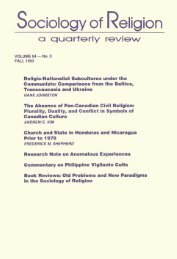The Sources of Gender Role Attitudes among Christian and Muslim ...
The Sources of Gender Role Attitudes among Christian and Muslim ...
The Sources of Gender Role Attitudes among Christian and Muslim ...
You also want an ePaper? Increase the reach of your titles
YUMPU automatically turns print PDFs into web optimized ePapers that Google loves.
214 SOCIOLOGY OF RELIGION<br />
quadratic term. I include the quadratic term to account for potential<br />
nonlinearity in the relationship between age <strong>and</strong> gender ideology.<br />
RESULTS<br />
Table 1 examines respondents' characteristics separately by <strong>Muslim</strong> (39.3<br />
percent) <strong>and</strong> <strong>Christian</strong> (54.1 percent) affiliation. 9 <strong>The</strong> data show that both<br />
<strong>Muslim</strong> <strong>and</strong> <strong>Christian</strong> women sampled are fairly progressive in their gender role<br />
attitudes, with <strong>Muslim</strong>s holding more traditional views than their <strong>Christian</strong><br />
counterparts (mean scores <strong>of</strong> 11.37 <strong>and</strong> 10.63, respectively). Table 1 next exam-<br />
ines differences <strong>among</strong> respondents on key predictor variables. Looking first at<br />
dimensions <strong>of</strong> Amb ethnicity, <strong>Muslim</strong> respondents are twice as likely to be<br />
foreign-bom (69.5 percent compared to 36.2 percent <strong>of</strong> <strong>Christian</strong>s), <strong>and</strong> <strong>of</strong> those<br />
foreign-born, are more likely to be newer immigrants -- 14.4 percent have<br />
resided in the U.S. for less than 15 years compared to 9.2 percent <strong>of</strong> <strong>Christian</strong><br />
women. It is noteworthy that the majority <strong>of</strong> foreign-born women, both Christ-<br />
ian <strong>and</strong> <strong>Muslim</strong>, have lived in the U.S. for 15 years <strong>of</strong> more. MuslŸ women are<br />
also more likely to have an Arab husb<strong>and</strong> (65.5 percent compared to 38.4<br />
percent) <strong>and</strong> to share most or all <strong>of</strong> their organizational affiliations with other<br />
Arab members (53.4 percent compared to 29.2 percent). <strong>The</strong>se differences in<br />
ethnicity are consistent with known patterns <strong>of</strong> MusIim <strong>and</strong> <strong>Christian</strong> emigra-<br />
tion from the Middle East.<br />
<strong>Muslim</strong> <strong>and</strong> <strong>Christian</strong> respondents are likewise diverse in their |evels <strong>of</strong><br />
religious involvement <strong>and</strong> strength <strong>of</strong> religious beliefs. Attendance rates <strong>among</strong><br />
<strong>Christian</strong> women ate high, with nearly three-fourths (72.5 percent) reporting<br />
that they attend services once or more a month. <strong>Muslim</strong> women's rates are<br />
somewhat lower (44.7 percent), which may in part reflect Islamic restrictions on<br />
female attendance. <strong>Christian</strong> respondents also have greater exposure to religious<br />
socialization over the life-course, with 77.5 percent claiming high levels <strong>of</strong><br />
religiosity in childhood <strong>and</strong> adulthood compared to 65.6 percent <strong>of</strong> <strong>Muslim</strong><br />
women. <strong>The</strong> pattern is reversed, however, in their degree <strong>of</strong> religious conser-<br />
vatism. Compared to their <strong>Christian</strong> counterparts, <strong>Muslim</strong> women are twice as<br />
likely to believe in scriptural inerrancy (81.9 percent compared to 43.8 percent).<br />
This finding may reflect a general belief <strong>among</strong> <strong>Muslim</strong>s that the Koran was<br />
written by God, or it may suggest that belief in scriptural literalism is more<br />
representative <strong>of</strong> a conservative ideological stance than a relŸ attitude, per<br />
Se.<br />
9 Women who report "other" or "no" affiliation (6.6 percent) ate excluded from Tables 1 <strong>and</strong> 3 <strong>and</strong><br />
coded ~" in Table 2.<br />
Downloaded from<br />
http://socrel.oxfordjournals.org/<br />
by guest on January 18, 2013



